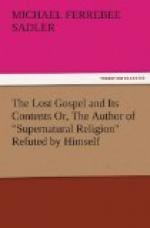“The description which Justin gives of the manner of teaching of Jesus excludes the idea that he knew the Fourth Gospel. ’Brief and concise were the sentences uttered by Him, for He was no Sophist, but His word was the power of God.’ (Apol. I. 14) No one could for a moment assert that this description applies to the long and artificial discourses of the Fourth Gospel, whilst, on the other hand, it eminently describes the style of teaching with which we are acquainted in the Synoptics, with which the Gospel according to the Hebrews, in all its forms, was so closely allied.” (Vol. ii. p. 315)
Now I assert, and the reader can with very little trouble verify the truth of the assertion, that the mode of our Lord’s teaching, as set forth in St. John, is more terse, axiomatic, and sententious—more in accordance with these words of Justin, “brief and concise were the sentences uttered by Him,” than it appears in the Synoptics.
To advert for a moment to the mere length of the discourses. The Sermon on the Mount is considerably longer than the longest discourse in St. John’s Gospel (viz., that occupying chapters xiv., xv., xvi.). This is the only unbroken discourse of any length in this Gospel. The others, viz., those with Nicodemus, with the woman at Sychem, with the Jews in the Temple, and the one in the Synagogue at Capernaum, are much shorter than many in the Synoptics, and none of them are continuous discourses, but rather conversations. And, with respect to the composition, those in St. John are mainly made up of short, terse, axiomatic deliverances just such as Justin describes.
Take, for instance, the sentences in the sixth chapter:—
“I am the bread of life.”
“He that believeth on me hath everlasting life.”
“I am that bread of life.”
“This is the bread that
cometh down from heaven, that a man should
eat thereof and not die.”
“My flesh is meat indeed, and my blood is drink indeed.”
“It is the spirit that quickeneth, the flesh profiteth nothing.”
And those in the tenth:—
“I am the door of the sheep.”
“I am the good shepherd:
the good shepherd giveth his life for the
sheep.”
“I am the good shepherd, and know my sheep, and am known of mine.”
Then, if we compare parables, the passage in the Fourth Gospel most resembling a parable, viz., the similitude of the Vine and the branches, is made up of detached sentences more “terse” and “concise” than those of most parables in the Synoptics.
The discourses in St. John are upon subjects very distasteful to the author of “Supernatural Religion,” and he loses no opportunity of expressing his dislike to them; but it is a gross misrepresentation to say that the instruction, whatever it be, is conveyed in other than sentences as simple, terse, and concise as those of the Synoptics, though the subject-matter is different.




